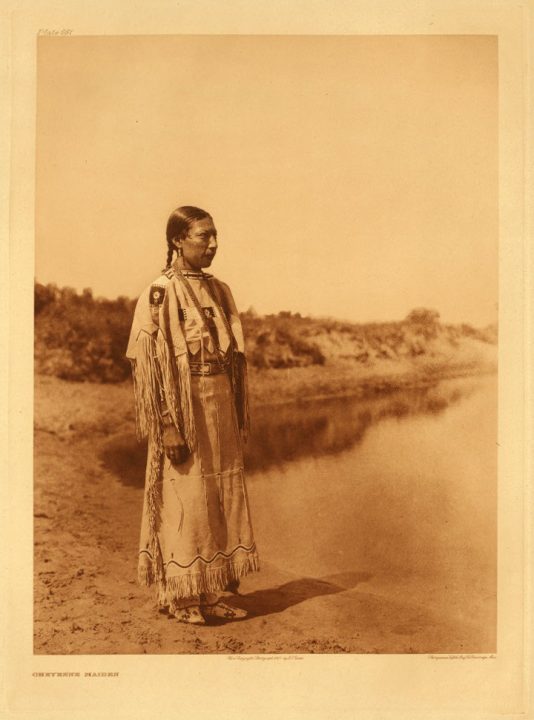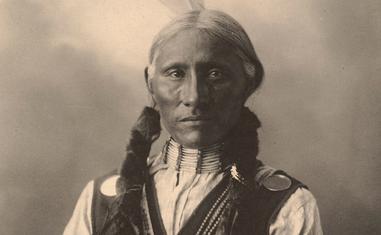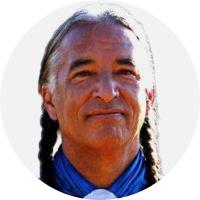The views expressed in our content reflect individual perspectives and do not represent the authoritative views of the Baha'i Faith.
Cheyenne Medicine, a book that explains the sacred teachings of the Cheyenne holy messenger Sweet Medicine, includes a list of those remarkable spiritual principles, which the Baha’i principles echo:
[1] Peacemaking: “You chiefs are peace makers. Though your son might be killed in front of your tepee, you should take a peace pipe and smoke. Then you would be called an honest chief.
[2] Protecting Land and People: “You chiefs own the land and the people. If your men, your soldier societies, should be scared and retreat, you are not to step back but take a stand to protect your land and your people.”
[3] Consultation: “Get out and talk to the people.”
[4] Hospitality: “If strangers come, you are the ones to give presents to them and invitations.”
[5] Generosity and Philanthropy: “When you meet someone, or he comes to your tepee asking for anything, give it to him. Never refuse. Go outside your tepee and sing your chief song, so all the people will know you have done something good.”
[6] Marriage: “The Cheyennes were not supposed to marry too young or to anyone related to them.”
[7] Against Theft/Unauthorized Use: “They were not to take anything by force, from another person, or use it without permission.”
[8] Against Gossip: “ … or to say bad things about others, especially the leaders or chiefs.”
[9] Dignity in Appearance: “They were to take pride in their bodies and the way they appeared …”
[10] Cleanliness: “… to keep clean …”
[11] Health: “… stay healthy.” – John Stands-in-Timber and Margot Liberty, Cheyenne Memories.
Q: These teachings are based on a series of interviews of John Stands-in-Timber by the anthropologist Margot Liberty, which have been published verbatim, in their entirety.
In her Introduction, Margot Liberty wrote: “John was especially interested in passing the tribal traditions on to the younger generation of Cheyennes—the teachings of Sweet Medicine and history concerning the Sacred Medicine Hat and the Sacred Arrows.”
So Kevin, I invite your comments on Sweet Medicine’s sacred teachings, as recounted by Cheyenne tribal historian, John Stands-in-Timber, and how the Baha’i teachings resonate with then, as well as complement and expand on them.
A: In 1972–73, during my freshman year at Black Hills State College (now University), my two best buddies – Larry Medicine Bull and Burt Kaline, both Cheyennes from Birney, Montana – so disliked speaking English that I would rarely hear them use it. When they did speak English, they always spoke very kindly and with great consideration, and were always sure to ascribe these teachings to Sweet Medicine. During my sophomore year at Haskell Junior College (now Haskell Indian Nations University), my roommates – Leonard Elk Shoulder, Roy Bull Coming, John Fox and Wilbur Wolf Voice – all exclusively spoke Cheyenne among themselves and carried themselves with great dignity and thoughtfulness, again citing the teachings of Sweet Medicine.

For over 50 years, I have made regular pilgrimages to Bear Butte. The Lakota have always reverenced this sacred mountain, being sure to solemnly recognize the fact that this was the place where Sweet Medicine passed through the sacred portal and entered the presence of the heavenly concourse, was invited to be seated beside the “Lord of the Dawn,” the Heavenly Grandfather, where Sweet Medicine was given the divine commandments and laws that would eternally bless and guide the earthly grandchildren upon the straight path throughout this world and beyond. For me, that resonates clearly with Baha’u’llah’s injunction in Epistle to the Son of the Wolf to follow the spiritual teachings of the messengers of God, which he called the Straight Path:
… We bear witness unto that whereunto God hath Himself borne witness ere the creation of the heavens and of the earth, that there is none other God but Him, the Almighty, the All-Bounteous. We testify that He is One in His Essence, One in His Attributes. He hath none to equal Him in the whole universe, nor any partner in all creation. He hath sent forth His Messengers, and sent down His Books, that they may announce unto His creatures the Straight Path.
Q: Fascinating – and it also raises the issue of how Sweet Medicine received his sacred teachings. Kevin, please let us know what you think of this one version, according to Cheyenne tribal historian John Stands-in-Timber:
“Many centuries ago the prophet and savior Sweet Medicine came to the prairie people. Before his birth the people were bad, living without law and killing one another. But with his life those things changed. Indians are often called savages, and it was true of the Cheyennes at first, but not after Sweet Medicine’s time. …
What happened to Sweet Medicine while he was gone was not known to the people for a long time, but on his return he told them of his experiences. He had traveled a long way, deep into the heart of the Black Hills country, where he seemed to be called by some great power. At last he reached a mountain known ever since by the Cheyennes as Noahvose, the Sacred or Holy Mountain; today it is called Bear Butte. Here he entered and found a place like a big lodge or tepee. Old women were sitting along one side and old men along the other. But they were not really people, they were gods. And he saw four arrows there, which were to become the Four Sacred Arrows of the Cheyenne tribe.
The old ones called him Grandson and began instructing him in many things he should take back to the people. They taught him first about the arrows, because they were to be the highest power in the tribe. Two were for hunting and two for war. Many ceremonies were connected with them, and they stood for many laws. He was taught the ceremony of renewing the arrows, which must take place if one Cheyenne ever killed another. The arrows had to be kept by a special priest in a sacred tepee, covered at all times unless the Arrow Ceremony was under way.
Sweet Medicine learned next that he was to give the people a good government, with forty-four chiefs to manage it, and a good system of police and military protection, organized in the four military societies—the Swift Foxes, Elks, Red Shields, and Bowstrings. There was so much more to learn besides these things that he was there for most of the four years, before he was sent forth again to carry the laws to the people. One of the old ones came out before him, burning sweet grass as incense to purify the air for the arrow bundle. And with it in his arms he started for home.
When he reached Cheyenne country the first ones who saw him were children, up in the hills gathering wild mushrooms or lichen for their parents. … Sweet Medicine saw what the children were doing and drew near to talk to them with the bundle in his arms. …
’Go and tell the people to prepare a tepee for me,’ he instructed them. ’I am coming in with a great power, for all the Cheyenne tribe.’” – John Stands-in-Timber and Margot Liberty, Cheyenne Memories.
A: The word Cheyenne is an Anglicized version of the Dakota Šaíyena – “They Who Speak Red” – a very cryptic name unless one understands that the color red is associated with everything holy and heavenly. I have always thought of it as an allusion to the power, efficacy and potency of the commandments given to the people through Sweet Medicine from the Grandfather – the Great Spirit, or God.
The Cheyenne have been among the most persecuted and downtrodden kindreds on the planet, yet they retain their devotion and piety to Sweet Medicine’s teachings. It delights me to bring this aspect of the spiritual heritage of the Western Hemisphere to the attention of all the BahaiTeachings.org readers.


















Comments
Sign in or create an account
Continue with Facebookor